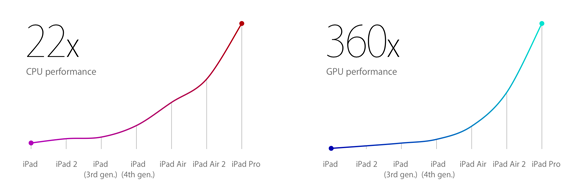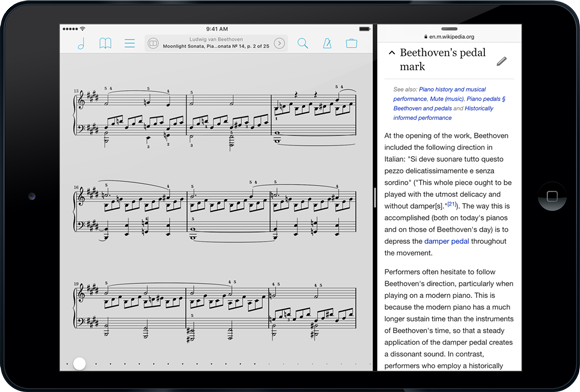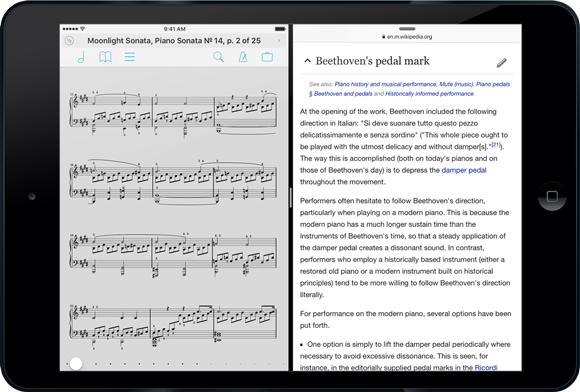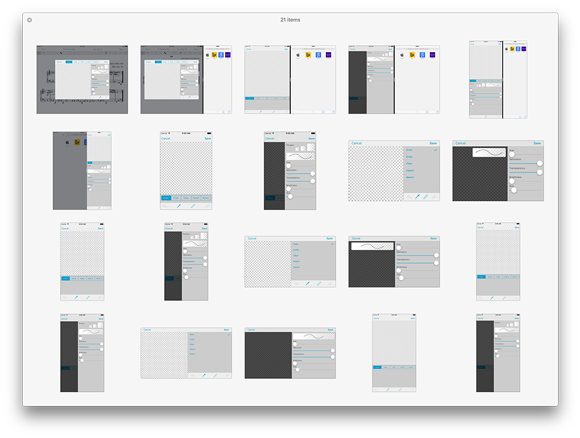Either we missed this last week at the Apple store or they just weren’t up yet, but forScore is being featured on one of the banners at the retail stores that use them. The image is part of Apple’s holiday gifts marketing series, and more can be found on their website. Check it out below, and special thanks to twitter user @RealAppleNerd for letting us know!

Today we’re happy to announce the immediate availability of forScore 9.2 and forScore mini 2.2. These updates contain a bunch of improvements, fixes, and changes, but for iPad Pro users the biggest news is the addition of an optional, customizable fourth menu item on either side of the control bar. This provides a great way for power users to access the features they use most frequently like Links, Services, Dashboard, and Groups.
Speaking of Groups, the member limit has been raised with this update from ten to thirty. We’re still taking a conservative approach to the service, but we’re excited to continue rolling it out so more and more groups can leave the pain of manual file and setlist coordination behind.
As always, these updates are completely free for existing users, so be sure to check out forScore 9.2 and forScore mini 2.2 today!
The iPad Pro is here, and we’ve finally had a chance to run forScore on some real hardware. Simply put, forScore on iPad Pro is incredible. It runs beautifully and looks great, and it’s easily the best forScore experience by a mile.
There have been many attempts to try and demonstrate just how big the iPad Pro is by stacking it up against other iPads, phones, and even iPod Nanos, but there’s really no substitute for picking one up and holding it. Fortunately, demo units are available at many (if not all) Apple retail stores.
Better yet, and this part is really exciting for us, the iPad Pros at these Apple stores are featuring a forScore demo. This is a special version of forScore we made specifically for this purpose, and it’s a slightly tweaked variant of forScore 9.1.3. A few features are disabled (like Restrictions), but it’s otherwise the complete experience. Developers can’t offer trial versions of their apps, so this is a great opportunity for anyone considering forScore to go and try it out for themselves.
Although they’re not shipping yet, we were able to try out an Apple Pencil with forScore on one of these demo units as well. Without any optimizations whatsoever, Apple Pencil is already a game-changer for annotation in forScore. It’s much more accurate, and the system-level palm rejection seems flawless. Seriously, just go try it out if you can. It’s fantastic.

If you’re in the market for an upgrade this year, you may be wondering how best to balance cost and performance. Many retailers now sell iPads (often at a discount), and used or refurbished iPads are a great deal for budget-conscious shoppers. Before you decide, consider this jaw-dropping chart from Apple comparing the performance of their various iPad models:

Of course, those are best-case scenario numbers. So how does upgrading actually affect your everyday usage with forScore? We gathered up a few of our development iPads and ran some tests to find out, and the short version is that if you’re still using an iPad 2, iPad mini, or the infamous iPad 3, you’ll see some very nice improvements by moving to a newer model. On average, everyday forScore tasks were almost 3 times faster on iPad Airs than they were on these older devices. Those seconds really add up and save you a huge amount of time over the course of a year or two.
In our testing, the iPad 3 actually fared the worst. Its graphics performance may be technically better than the iPad 2, but as the first iPad with a Retina screen it uses four times the number of pixels. The increase in detail more than offsets the improvements in performance, and no one looking for a used iPad should buy one of these. If you’re considering one of these as your first iPad and you really want the Retina screen, stick with an iPad 4 or newer, or if you need to save money consider the enduring iPad 2 (which is still the most popular model in use).
For shoppers with a little more room in their budgets, the iPad Air and iPad Air 2 really take the cake. These devices are incredibly fast and the difference between the two really comes down to whether or not you want to take advantage of iOS 9’s new split screen multitasking mode. If you want to be able to run two apps side by side, you’ll need an iPad Air 2. Otherwise, the two iPad Air models are relatively similar in terms of performance, so either will serve you well for years to come.
And finally, the long-awaited iPad Pro. Whether or not you opt for this newest member of the iPad lineup probably comes down to two factors: screen size and the new Apple Pencil. The former is fairly obvious, bringing each page of your music much closer to its original physical dimensions than with previous iPads. The Pencil promises improved precision and responsiveness, and is only compatible with the iPad Pro. If either of these two things matter to you and you can afford the price tag that’s seemingly proportional to screen size, absolutely consider this huge (sorry) upgrade.
Here are our recommendations:
- iPad 1: Not compatible with forScore, do not buy!
- iPad 2: Recommended only for customers with very tight budgets
- iPad 3: Not recommended
- iPad 4: Recommended
- iPad Air: Highly recommended if you don’t need Split View multitasking
- iPad Air 2: Highly recommended
- iPad mini: Recommended only for customers with very tight budgets
- iPad mini 2: Recommended
- iPad mini 3: Not recommended (very similar to the cheaper iPad mini 2)
- iPad mini 4: Highly recommended
- iPad Pro: Highly recommended, of course!
The new iPad Pro’s release seems to be mirroring in many ways its introduction: lots of waiting and virtually no information. At this point, all we know from Apple is that the device is coming this month. There’s a little more to be gleaned from tweaks to the App Store, however, and we’ve got a few more things coming in forScore 9.2 that’ll take full advantage of the iPad Pro’s huge screen. So, while we wait, we thought we’d give you a look at where things currently stand.
First, the App Store: not long ago Apple started advertising apps as optimized for iPad Pro in the “Compatibility” fine print. Since then they’ve even allowed developers to start uploading iPad Pro-sized screenshots. While we had originally assumed that an update would be required to support the new hardware, it looks like that’s not the case. As far as we can tell, any app that supports iOS 9’s new multitasking modes also automatically works on the iPad Pro, so we’ll be ready on day one.
We’re not content to just add basic compatibility, though, so we took some time to figure out where we could add features that take advantage of this extra screen real estate. The big one coming in forScore 9.2 is the addition of an optional, customizable fourth menu item on either side of the control bar. Most of the items in the tools menu are available here, so you can do things like open the Services panel or the new Button creator right from the main view. It’s a great way to add instant access to those features you use most often, and we think it’ll be a fantastic upgrade.

Finally, we’ve added basic support for Apple Pencil. There’s really not much info to go on at this point (Apple’s developer documentation is very light on this topic) but we’ll have a lot more tweaking to do once we have the actual device in hand. For now, forScore will work just like it does with a stylus like the FiftyThree Pencil, but with higher precision that’s only available when using both an iPad Pro and Apple Pencil.
We’ve done a lot so far, and we can’t wait to keep pushing forward just as soon as we can. Once we have more information, we’ll let you know right here, so stay tuned!
Update: Apple has announced that the iPad Pro will be available for order this Wednesday, and will arrive in stores “later this week.”
September 16, 2015
| Feature of the Week, News
Today’s release of iOS 9 means some of you will just be getting started with new iPad multitasking modes, Split View and Slide Over. So what are they? How do they work? What silly things can you do with them? Keep reading this special Wednesday edition of Feature of the Week and you’ll soon be a pro, ready to impress your colleagues and show them how it’s done:
Slide Over
The first new multitasking mode for iOS 9 is Slide Over, a feature that lets you temporarily bring another app into view over the current app from the right-hand side of your screen. While viewing an app, just slide your finger from the right edge of the screen into the middle. You’ll see a vertical list of icons for the apps that support Slide Over, and you can tap on one to open it. This lets you do something quick like respond to a message or check a web page without closing the current app first. The main app will dim and won’t be interactive while you’re working with the second app, but you can swipe from left to right or tap on the dimmed app to dismiss the second app and continue what you were doing.

Once you’ve picked an app it’ll be the one you see each time you use Slide Over (unless iOS closes it to free up memory), but you can swipe down from the top of the screen within the Slide Over area to choose another app to use here. Apps must be updated to support Slide Over, so the list of available apps may be limited until more developers get on board. On the other hand, developers must specifically opt out of support for being the primary (dimmed) app, so you should be able to activate Slide Over from within most apps.
Slide over is compatible with iPad Air or newer, iPad mini 2 or newer, and the new iPad Pro (once it’s released this fall).
Split View
If you’re using an iPad Air 2, the brand new iPad mini 4, or once you get your hands on the upcoming iPad Pro, you’ll also be able to use Split View. With Split View you can run two apps side-by-side and work with them simultaneously. Unlike Slide Over, neither app is dimmed or inactive, so you can use them like you normally would. To use Split View, swipe from the right just like you do with Slide Over, then enlarge the window by dragging its left edge into the center of the screen. Your two apps will blur and display their icon until you let go, settling in to their respective sides of the screen.

You get a little bit of control over how much space each app takes up on the screen, but only in landscape orientation. In portrait, the app on the right gets the classic iPhone width of 320 pixels, while the app on the left gets the rest. In landscape mode, you can choose one of two options: the same 320 pixels on the right and the remaining space on the left, or a 50/50 split. Just drag the divider left or right to change which option you’re using.

When you need to focus on one app or the other, just drag that dividing line all the way to the left or right, depending on which app you want to keep. The other will be closed just like it normally does when you press the home button.
Speaking of the home button, if you press it while working in split view, iOS will close both apps but remember which one was on the right and use it in combination with whatever app you open next.
Side Effects
As it so happens, there are a few things you can do that are probably useless but fun to try anyway. First, if you’ve downloaded today’s update to forScore Cue, you can use Split View to see forScore on one side of the screen while controlling it from Cue on the other. You can also activate Console in forScore and use Safari at the same time to edit your library (it doesn’t work well—we’ve never needed to optimize the Console web editor for a mobile device, so be warned).
So now you’re a pro at multitasking on iPad with iOS 9 and forScore 9.1. Tell your friends!
September 15, 2015
| News
iOS 9 is coming tomorrow, so many of you are wondering if forScore will work properly if you choose to update. Although there were some major bugs with early beta versions of iOS 9, Apple has since fixed them and we are happy to report that we’re not aware of any compatibility issues with the current versions of forScore and forScore mini.
Of course, if you’re itching to install iOS 9 you’re probably anxious to try out all of the new features, so today we’re proud to announce the immediate availability of forScore 9.1 and forScore mini 2.1.
With forScore 9.1, you’ll be able to take advantage of iOS 9’s new Split View and Slide Over multitasking modes, an improved drawing experience (especially if you’re using an iPad Air 2), and some clever keyboard enhancements. Of course, we already did most of the work required to support these new features earlier this summer with forScore 9, so it’s exciting to be able to finally show it all off.
Both forScore 9.1 and forScore mini 2.1 include a few bug fixes and improvements like a more flexible tuning option for the pitch pipe’s tone generator, so even if you’re sticking with iOS 8 for now there’s something for everyone.
As always, these updates are completely free for existing users, so be sure to check out forScore 9.1 and forScore mini 2.1 today!
Apple’s announcements today have finally put an end to the years of speculation: an iPad Pro is coming later this year. Many people have already contacted us wondering if we’ll be supporting it and the answer is an absolute yes.
In fact, forScore seems to work pretty much as-is thanks to the changes we’ve already made to support iOS 9’s new multitasking modes. Here’s a screenshot:

We’re just getting started with the iOS 9.1 beta that’ll be required to support the iPad Pro when it’s released this November, so we don’t any final information at this point, but it’s looking great so far. We also don’t have any information regarding the new Apple Pencil, but we fully expect to be able to support it and the new keyboard accessory later this year. As with most things, we just can’t guarantee anything until we have these new devices in hand.
Until then, we’ll be putting the final touches on forScore 9.1, forScore Cue 1.3, and TuneWave 1.1 all with support for iOS 9’s Slide Over and Split Screen multitasking modes. One thing is for certain: it’s going to be a busy fall!
August 13, 2015
| In Depth, News
The first iPhone apps were wonderfully simple from a design standpoint. Developers could create one, perhaps two (if they supported landscape orientation) pixel-perfect layouts and know that their interface would always look exactly the same. Unlike PCs with windowed software that’s almost infinitely resizable, mobile software on the iPhone began with a single screen size: 320 pixels wide, 480 pixels tall, with a 20 pixel high status bar along the top.
Later, the iPhone 5 ushered in Apple’s first mobile screen size change and the iPhone 6 and 6 plus pushed those limits even further. Meanwhile, iOS 7 blurred the lines between the status bar and an app’s interface canvas. For the most part, however these shifts were subtle. An app designed for an iPhone 4 can usually scale up to the iPhone 6 plus by simply displaying more content or by adding space between sets of controls. In fact, much of this happens automatically.
With iOS 9, however, things are shifting more dramatically. Apple’s new multitasking modes for iPad can contort apps into some very unique shapes. The wildest example, perhaps, is the 320 pixel wide but 1024 pixel tall column that apps can be put into when used in Slide Over or as a secondary app with Split Screen. Some interface elements like long scrolling table views, for instance, can handle this shape just fine. Other specialty panels have a harder time.
The best example of this is forScore’s Stamp creator/editor. It allows users to draw their own stamps onto a square canvas, so everything has to be designed around that. That leaves varying amounts of space either on the bottom or the right of the canvas, depending on the situation. Combine two possible interface orientations with five screen sizes and add four additional app window sizes for the new iPad multitasking modes and you come up with over a dozen different possible layouts. Adding more space just doesn’t cut it here.

So we had to take a different approach. The panel’s major collections of interface elements (the canvas, the tool picker, the drawing style sliders, and the stamp previews) all had to be isolated and presented with a hierarchy of importance. Some things move around as needed, others collapse into hidden areas, and still others disappear entirely if there’s just no room for them. It’s a far cry from simply designing one, two, or three different layouts for different screen sizes.
Another example is the metadata panel. On an iPad, when using most of the new split-screen modes, the menus are presented full-screen instead of within popovers. Unlike an iPhone, however, the iPad layouts are much taller and leave a bunch of empty space at the bottom. So now, if you’re using one of these modes, you’ll see additional statistics from forScore 9’s new Dashboard feature. It’s helpful, but not essential, so it can appear when practical and disappear otherwise.
Like many of Apple’s biggest paradigm shifts, there isn’t a single point at which every developer switches from one approach to the next. The tools and technologies are usually optional, and some of them never end up making sense for a particular app. At some point, though, one more change can be enough of a push. For us, now, this is the pivot point. No longer can we design around devices, we must consider how we use space—any amount of space—even on devices that haven’t been released yet. It’s a big challenge, and one we won’t get right every time, but it’s exciting and we can’t wait to show you what we’ve done when iOS 9 is released later this year.
Today we’re very excited to announce the immediate availability of our next major updates, forScore 9.0 and forScore mini 2.0. Over the past several weeks, we’ve given you a sneak peek at what’s new and improved, from completely new features like Buttons and Dashboard to the improvements we’re making to the metadata panel, stamps, and our audio utilities.
Those are the biggest changes, but these updates include a whole lot more like a new full-screen menu option in the accessibility section of the settings panel and an improved page caching system that makes reopening recent files much faster. All of these changes add up to make these the best versions of forScore yet, and we hope you love them.
We’ve also done a lot of work to get ready for iOS 9 and to take full advantage of the new split-screen multitasking modes. Although we’re not allowed to ship full support for these modes just yet, the changes we’ve made to prepare have been extensive and exiting. We haven’t just made sure everything works all right, we’ve taken a lot of time to figure out how we can best use the available space without cramming things in. We’ll have more on this soon, but it’s very cool.
Of course, these great updates could never have happened without the amazing support of our customers, so thank you once again for your tremendous enthusiasm and feedback. As always, these updates are completely free for all existing users, so be sure to check out forScore 9.0 and forScore mini 2.0 today!








